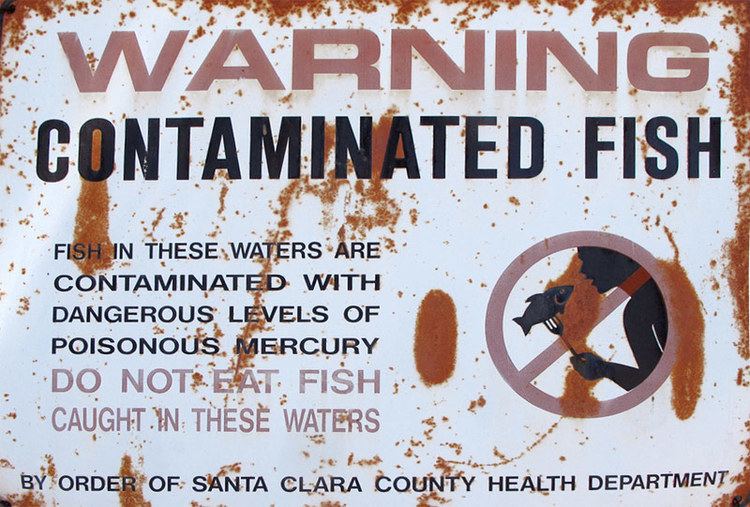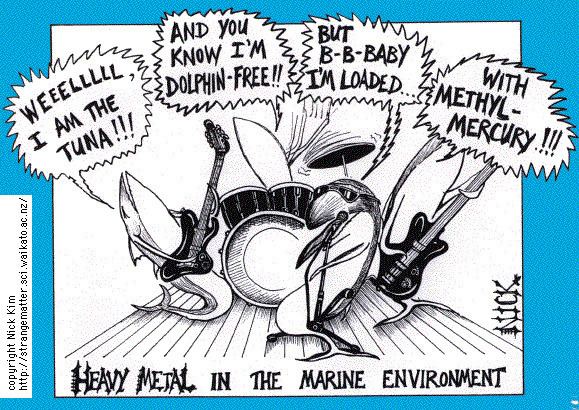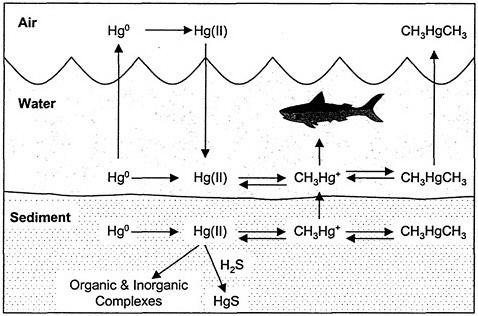 | ||
Methylmercury
Methylmercury (sometimes methyl mercury) is an organometallic cation with the formula [CH3Hg]+. It is a bioaccumulative environmental toxicant.
Contents
- Methylmercury
- Diagnosis of methylmercury poisoning from seafood consumption
- Structure and chemistry
- Human health effects
- Effects on fish and wildlife
- In public policy
- References
Diagnosis of methylmercury poisoning from seafood consumption
Structure and chemistry

"Methylmercury" is a shorthand for "monomethylmercury", and is more correctly "monomethylmercury(II) cation". It is composed of a methyl group (CH3-) bonded to a mercury ion; its chemical formula is CH3Hg+ (sometimes written as MeHg+).

As a positively charged ion it readily combines with anions such as chloride (Cl−), hydroxide (OH−) and nitrate (NO3−). It also has very high affinity for sulfur-containing anions, particularly the thiol (-SH) groups on the amino acid cysteine and hence in proteins containing cysteine, forming a covalent bond. More than one cysteine moiety may coordinate with methylmercury, and methylmercury may migrate to other metal-binding sites in proteins.
Human health effects

Ingested methylmercury is readily and completely absorbed by the gastrointestinal tract. It is mostly found complexed with free cysteine and with proteins and peptides containing that amino acid. The methylmercuric-cysteinyl complex is recognized by amino acid transporting proteins in the body as methionine, another essential amino acid. Because of this mimicry, it is transported freely throughout the body including across the blood–brain barrier and across the placenta, where it is absorbed by the developing fetus. Also for this reason as well as its strong binding to proteins, methylmercury is not readily eliminated. Methylmercury has a half-life in human blood of about 50 days.

Several studies indicate that methylmercury is linked to subtle developmental deficits in children exposed in-utero such as loss of IQ points, and decreased performance in tests of language skills, memory function and attention deficits. Methylmercury exposure in adults has also been linked to increased risk of cardiovascular disease including heart attack. Some evidence also suggests that methylmercury can cause autoimmune effects in sensitive individuals. Despite some concerns about the relationship between methylmercury exposure and autism, there are few data that support such a link. Although there is no doubt that methylmercury is toxic in several respects, including through exposure of the developing fetus, there is still some controversy as to the levels of methylmercury in the diet that can result in adverse effects. Recent evidence suggests that the developmental and cardiovascular toxicity of methylmercury may be mitigated by co-exposures to omega-3 fatty acids and perhaps selenium, both found in fish and elsewhere

There have been several episodes in which large numbers of people were severely poisoned by food contaminated with high levels of methylmercury, notably the dumping of industrial waste that resulted in the pollution and subsequent mass poisoning in Minamata and Niigata, Japan and the situation in Iraq in the 1960s and 1970s in which wheat treated with methylmercury as a preservative and intended as seed grain was fed to animals and directly consumed by people (see Basra poison grain disaster). These episodes resulted in neurological symptoms including paresthesias, loss of physical coordination, difficulty in speech, narrowing of the visual field, hearing impairment, blindness, and death. Children who had been exposed in-utero through their mothers' ingestion were also affected with a range of symptoms including motor difficulties, sensory problems and intellectual disability.

At present, exposures of this magnitude are rarely seen and are confined to isolated incidents. Accordingly, concern over methylmercury pollution is currently focused on more subtle effects that may be linked to levels of exposure presently seen in populations with high to moderate levels of dietary fish consumption. These effects are not necessarily identifiable on an individual level or may not be uniquely recognizable as due to methylmercury. However, such effects may be detected by comparing populations with different levels of exposure. There are isolated reports of various clinical health effects in individuals who consume large amounts of fish; however, the specific health effects and exposure patterns have not been verified with larger, controlled studies.
Many governmental agencies, the most notable ones being the United States Environmental Protection Agency (EPA), the United States Food and Drug Administration (FDA), Health Canada, and the European Union Health and Consumer Protection Directorate-General, as well as the World Health Organization (WHO) and the United Nations Food and Agriculture Organization (FAO), have issued guidance for fish consumers that is designed to limit methylmercury exposure from fish consumption. At present, most of this guidance is based on protection of the developing fetus; future guidance, however, may also address cardiovascular risk. In general, fish consumption advice attempts to convey the message that fish is a good source of nutrition and has significant health benefits, but that consumers, in particular pregnant women, women of child-bearing age, nursing mothers, and young children, should avoid fish with high levels of methylmercury, limit their intake of fish with moderate levels of methylmercury, and consume fish with low levels of methylmercury no more than twice a week.
Effects on fish and wildlife
In recent years, there has been increasing recognition that methylmercury affects fish and wildlife health, both in acutely polluted ecosystems and ecosystems with modest methylmercury levels. Two reviews document numerous studies of diminished reproductive success of both fish, fish-eating birds, and mammals due to methylmercury contamination in aquatic ecosystems.
In public policy
Reported methylmercury levels in fish, along with fish consumption advisories, have the potential to disrupt people's eating habits, fishing traditions, and the livelihoods of the people involved in the capture, distribution, and preparation of fish as a foodstuff for humans. Furthermore, proposed limits on mercury emissions have the potential to add costly pollution controls on coal-fired utility boilers. However, much if not most of the distributed mercury depositional input is from natural sources. Pre-Anthropocene tissue-bound levels in fish may not have differed markedly from current levels, bringing into question whether economically and environmentally expensive political regulatory measures would be ineffectual and moot. Still, the methylmercury mitigation issue has attracted the attention of many levels of government (see selected external links), environmental groups, consumer advocates, science groups, and significant interest from electric utilities.
